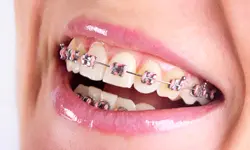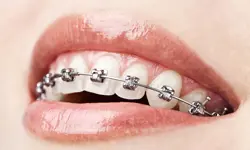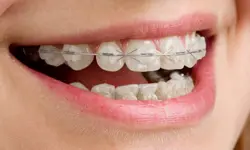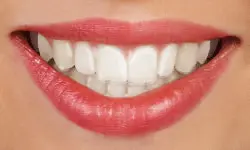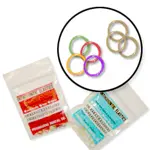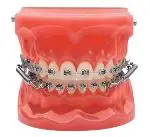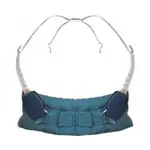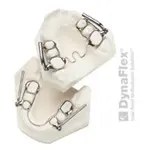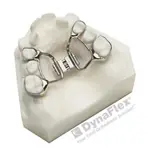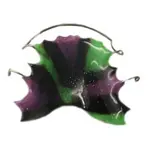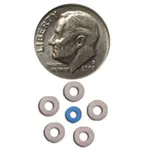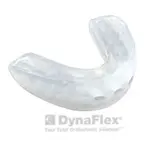BRACES TACOMA WA
Achieve a Straighter, Healthier Smile With Braces
Braces have come a long way, and today, they are more comfortable and effective than ever before. At Pacific Northwest Orthodontics, we understand the importance of achieving a beautiful, healthy smile. Orthodontic treatment plays a crucial role in enhancing both your dental health and your confidence, so we offer a range of braces Tacoma WA to help you get your dream smile.
Book a Free Consultation
Traditional Metal Braces
Traditional metal braces are the most common type of braces. They are made of high-grade stainless steel and use metal brackets and archwires to straighten your teeth. While you may remember them as bulky and uncomfortable, modern metal braces are smaller and more comfortable than ever. You can even add colored elastics (rubber bands) to make your smile uniquely colorful.
Pros:
- Highly effective for treating complex dental issues.
- Cost-effective option compared to some alternatives.
- Colored elastics allow for personalization.
Cons:
- Visible metal appearance may be less aesthetically appealing.
- May cause temporary discomfort and difficulty with certain foods.
- Requires careful oral hygiene maintenance to prevent plaque buildup.
Self-Ligating Braces
Self-ligating braces offer a more convenient orthodontic experience. Made from the same materials as traditional braces, they eliminate the need for elastics, resulting in fewer appointments and reduced friction on your teeth. Self-ligating braces come in various options, including traditional metal, ceramic, or clear brackets. They use a specialized clip instead of elastics, which reduces pressure and requires fewer adjustments.
Pros:
- Fewer appointments and adjustments needed.
- Less friction on teeth compared to traditional braces.
- Variety of bracket materials, including metal, ceramic, and clear.
Cons:
- May be slightly more expensive than traditional braces.
- Not suitable for all orthodontic issues, particularly severe cases.
- Cleaning can still be challenging due to brackets and wires.
Clear (Ceramic) Braces
Ceramic braces are a discreet alternative to traditional metal braces. Made of clear materials, they are less visible on your teeth, making them a popular choice among older teenagers and adults who have cosmetic concerns. However, they require more attention to oral hygiene because they are slightly larger and more fragile than metal braces. They are often used on the upper front teeth for their subtle appearance.
Pros:
- Less noticeable due to clear or tooth-colored materials.
- Effective for treating various dental issues.
- Offer a more discreet option for older teenagers and adults.
Cons:
- More prone to staining, requiring careful maintenance.
- Slightly larger brackets can be less comfortable.
- May be more fragile and prone to breakage compared to metal braces.
Clear Aligners
Clear aligners offer a revolutionary approach to orthodontic treatment. These removable acrylic trays are nearly invisible, allowing you to straighten your teeth with confidence. You can eat, drink, brush, and floss without any hassle. Plus, clear aligners are comfortable and won’t cause mouth abrasions like traditional braces.
Pros:
- Nearly invisible, offering a discreet option.
- Removable for eating, drinking, brushing, and flossing.
- Shorter appointments and no need for adjustments.
Cons:
- Not suitable for all orthodontic issues, particularly complex cases.
- Requires diligent wear for 20 to 22 hours per day for best results.
- Can cause tooth soreness when removed, limiting food choices.
Life with Braces
It’s essential to understand what life will be like during your orthodontic journey. Our experts have provided the day-to-day aspects of living with braces Tacoma WA and guidance to help you navigate this exciting transformation.
Eating with Braces
One of the first questions many people have when they get braces is, “What can I eat?” While there are some dietary adjustments to consider, the good news is that you can still enjoy a wide range of foods. Here’s a breakdown of what to avoid and what you can savor:
Foods to avoid with braces:
- Chewy foods like bagels and licorice
- Crunchy foods such as popcorn, chips, and ice
- Sticky foods like caramel candies and chewing gum
- Hard foods like nuts and hard candies
- Foods that require biting into, like corn on the cob, apples, and carrots
Foods you CAN eat with braces:
- Dairy products like soft cheese, pudding, and milk-based drinks
- Breads such as soft tortillas, pancakes, and nut-free muffins
- Grains like pasta and soft-cooked rice
- Meats/poultry, including soft-cooked chicken, meatballs, and lunch meats
- Seafood options like tuna, salmon, and crab cakes
- Vegetables like mashed potatoes, steamed spinach, and beans
- Fruits like applesauce, bananas, and fruit juice
- Treats such as ice cream without nuts, milkshakes, Jell-O, and soft cake
While there are some restrictions, you’ll find that you can still enjoy a diverse and satisfying diet with braces. Just be mindful of the foods to avoid to prevent damage to your appliances.
Soreness Caused from Braces and Appliances
When you first get your braces, it’s normal to experience some tenderness or soreness in your mouth. This discomfort is temporary and part of the adjustment process. To alleviate any pain, we recommend the following solutions:
- Saltwater Rinse: Dissolve one teaspoon of salt in eight ounces of lukewarm water. Swish and gargle this solution in your mouth for a couple of minutes. Do not swallow the saltwater.
- Over-the-Counter Pain Reliever: If severe discomfort persists, consider taking a pain reliever.
- Orthodontic Wax: We provide orthodontic wax that you can use to reduce tenderness. You can apply the wax over the braces as needed.
Loose Teeth
You may notice that your teeth feel a bit loose when you have braces. Don’t worry; this is entirely normal. In fact, it’s a sign that your braces are working as intended. The braces gently loosen your teeth to reposition them correctly. Once they’ve been realigned, they will no longer feel loose.
Loose Wires and Bands
Occasionally, the wires and bands on your braces may come loose or shift. If this happens, it’s essential to contact us as soon as possible so that we can assess and repair your appliance. If any part of your appliance comes off, be sure to save it and bring it to our office.
In the meantime, you can temporarily address a loose wire by using the back of a spoon or the eraser end of a pencil to carefully and gently push the wire back into place. If the loose wire causes irritation to your lips or cheeks, you can place wax or a wet cotton ball over the broken wire to relieve any discomfort.
Taking Care of Your Appliances
Properly maintaining your orthodontic appliances is crucial to ensuring a successful treatment outcome. Your teeth and jaw can only move into their correct positions if you consistently wear any rubber bands, headgear, retainers, or other appliances prescribed by your orthodontist.
Playing Sports with Braces
Game, set, match—we have great news for athletes! You can still play sports even while undergoing orthodontic treatment! If you do play sports, it’s recommended that you wear a mouthguard to protect your teeth and your appliance. Let your doctor know if you need help finding the right mouthguard for the best protection.
In case of a sports emergency, be sure to immediately check your mouth and appliance for damage. If you notice any loose teeth or appliance damage, please contact our office right away. You can temporarily relieve the discomfort by applying wax or rinsing your mouth with warm saltwater.
Choosing the Right Type of Braces for You
Selecting the right type of braces is a significant decision, as it will impact your orthodontic journey and your smile’s outcome. To help you make an informed choice with Pacific Northwest Orthodontics, consider the following factors:
Aesthetics
If you prefer a more discreet option, clear (ceramic) braces, lingual braces, or clear aligners like Invisalign may be suitable choices. They are less noticeable compared to traditional metal braces.
Budget
Your budget is an important consideration. Traditional metal braces are often the most cost-effective option, while clear aligners and lingual braces tend to be on the higher end of the price spectrum.
Complexity of the Issue
The severity of your dental issues plays a role in the type of braces recommended. Some treatments may require the precision and control that traditional metal braces offer, especially for extreme overcrowding or complex malocclusions.
Personal Comfort
Consider your comfort level with different types of braces. Some individuals find metal braces comfortable, while others may prefer the aesthetics and comfort of clear or invisible options.
Dietary Habits
Your dietary preferences and habits can influence your choice. For instance, if you enjoy eating a wide variety of foods without restrictions, clear aligners might be a convenient option as they are removable during meals.
Orthodontist’s Recommendation
Your orthodontist’s expertise is invaluable. They will assess your dental needs and recommend the most suitable type of braces for your case. Trust their guidance and ask questions to make an informed decision.
Get Your Complimentary Consultation Today
Make an appointment for an orthodontic consultation with us today and get the smile you’ve always dreamed of. If you need help deciding whether braces are best for you, our expert orthodontists are glad to help. Seize the moment—the road to a confident smile begins right now!
Book Your Free Consultation
Types of Appliances
Elastics (Rubber Bands)
Wearing elastics (or rubber bands) improves the fit of your upper and lower teeth. Wear rubber bands as instructed, and remember that the rubber bands work far more efficiently if they’re worn as prescribed.
Forsus™
The Forsus Fatigue Resistant Device is an alternative to headgear which promotes growth in adolescents, helping to eliminate excessive overbites, improve the fit of teeth, and possibly prevent the need for jaw surgery.
Headgear
Headgear is used to treat patients whose teeth are in an overbite, with the upper jaw forward of the lower jaw, or an underbite with the lower jaw forward of the upper jaw. Headgear gently “pulls” on your teeth to restrict further forward growth of your upper teeth and jaw.
Herbst® Appliance
The Herbst® appliance reduces overbite by encouraging the lower jaw forward and the upper molars backward. This fixed appliance is used mostly for younger, growing children and is worn for about 12-15 months.
Palatal Expander
The palatal expander “expands” (or widens) your upper jaw by putting gentle pressure on your upper molars each time an adjustment is made. Your orthodontist will instruct you about when and how to adjust your expander. When you achieve the desired expansion, you will wear the appliance for several months to solidify the expansion and to prevent regression.
Retainers
Retainers may be removable or fixed. They hold your teeth in their new, correct positions after your teeth have been straightened. Your orthodontist will instruct you on how to care for your retainer and about the duration of the wear. Wearing your retainer as directed is crucial to prevent regression of your treatment.
Separators or Spacers
Separators are little rubber doughnuts that may be placed between your teeth to push them apart so that orthodontic bands may be placed during your next appointment. The separators will be removed before we place the bands. Separators do not mix well with sticky foods, toothpicks, or floss.
Positioners
Positioners complete the final tooth movements in your orthodontic treatment. With your full cooperation, you should only need to wear the positioner appliance for four to eight weeks.
